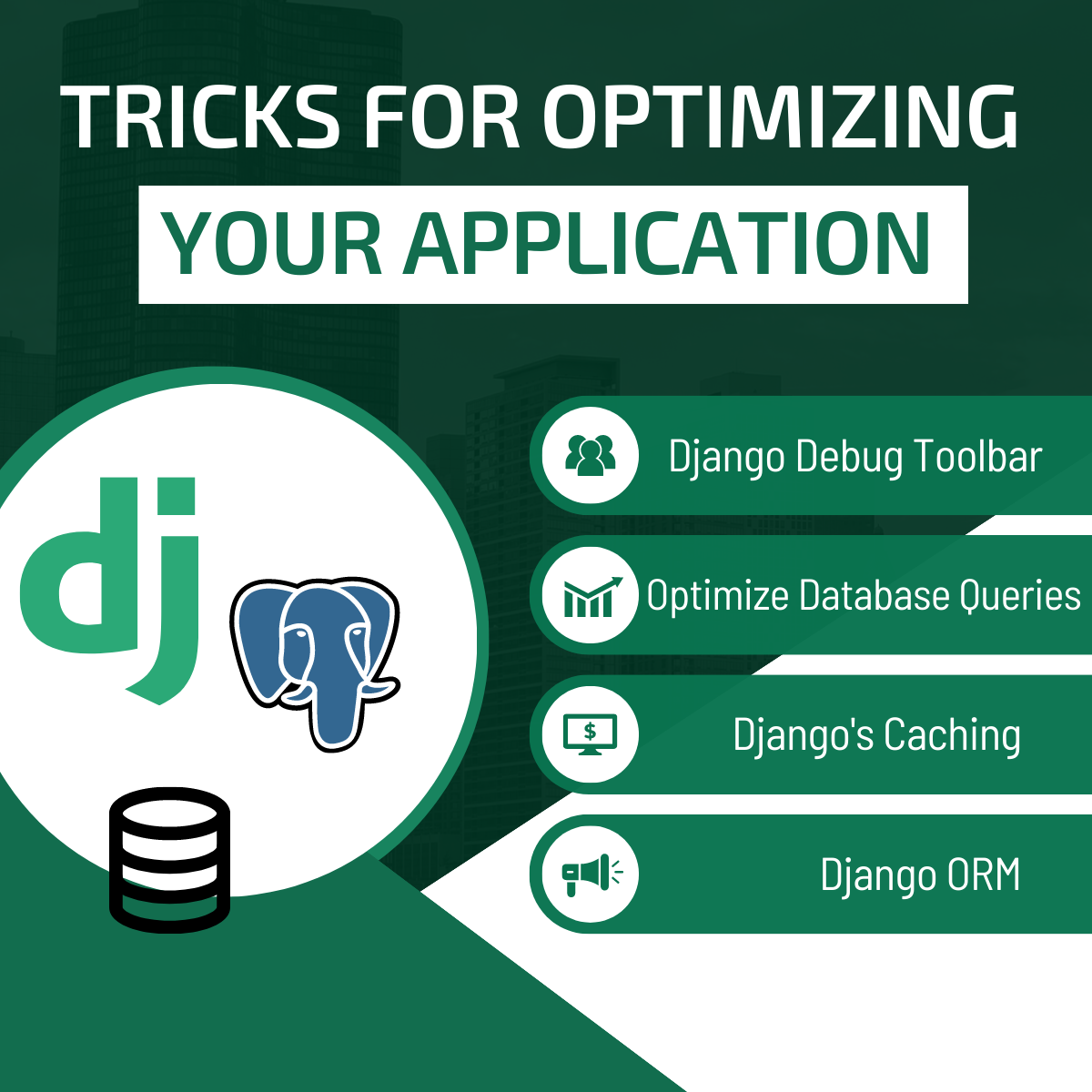Does your Django app development project leave users tapping their feet while waiting for pages to load? You’re not alone! But fear not, developer warriors! This blog is your guide to transforming your sluggish app into a performance powerhouse. We’ll reveal optimization procedures to supercharge your code, streamline database intelligence, and use caching for blazing-fast reaction times. So, buckle up and get prepared to unleash the full potential of your Django or Flask application!
Understanding Performance Optimization
Execution optimization includes a series of techniques and practices aimed at improving the speed and productivity of a web application. It includes different perspectives such as decreasing load times, upgrading responsiveness, and guaranteeing adaptability. The key metrics to focus on incorporate reaction time, throughput, adaptability, and resource utilization. By optimizing these metrics, developers utilizing devices like Django for app development can guarantee consistent and effective client involvement.
Overview of Django and Flask
Django Application Development
Python boasts a strong web framework called Django. Django streamlines web development by promoting clean, practical plans and advertising a wealth of built-in highlights, making it a favorite among developers.
Why Choose Django for App Development?
Django’s strength and adaptability make it perfect for creating complex web applications. Its “batteries-included” reasoning guarantees that developers have all the fundamental tools at their transfer, decreasing the requirement for third-party integration.
Flask Application Development
Flask, on the other hand, is a micro-framework that gives the essentials for web development without the additional stuff. It offers adaptability and control, permitting developers to tailor their applications to particular needs.
Why Choose Flask App Development?
Flask’s simplicity and modularity make it suitable for small to medium-sized applications. Its minimalistic approach provides developers with the freedom to choose their own components and libraries, fostering a more customized development process.
Performance Optimization Techniques in Django

Database Optimization
1. Query Optimization:
Efficient database queries are crucial for optimal performance in Django application development. The `select_related` and `prefetch_related` strategies can essentially decrease the number of questions made to the database, in this manner speeding up data recovery.
2. Indexing and Database Tuning
Proper indexing can drastically improve query performance. Ensure that your database tables are indexed on columns that are frequently used in query conditions. Additionally, database tuning parameters should be configured to match the specific workload of your application.
Caching
1. In-Memory Caching with Redis or Memcached
Caching regularly accessed information can minimize database load and improve reaction times. Redis and Memcached are well-known choices for in-memory caching, giving quick data recovery and decreasing inactivity.
2. Django’s Built-In Caching Framework
App development with Django offers a built-in caching framework that supports various backends, including in-memory caches like Redis and Memcached. Implementing caching strategies such as per-view caching, template fragment caching, and low-level caching can significantly enhance performance.
Code Optimization
1. Efficient Coding Practices
Writing clean and efficient code is fundamental to performance optimization in Django for app development. Avoiding redundant computations, using list comprehensions, and leveraging built-in functions can lead to faster execution, which is crucial for Django app development.
2. Reducing Middleware and Using Asynchronous Views
Middleware can add overhead to request processing in app development with Django. Evaluate the necessity of each middleware component and remove any that are not essential. Additionally, using asynchronous views can handle high concurrency more effectively, improving overall performance, which is vital for both Django mobile app development and Flask app development.
Load Balancing
1. Using Load Balancers to Distribute Traffic
Load adjusting distributes incoming activity over numerous servers, guaranteeing no single server is overwhelmed. This upgrades the application’s adaptability and unwavering quality, which is vital for app development with Django and Flask app development.
2. Example Setups with Nginx and Gunicorn
Nginx, combined with Gunicorn, is a popular setup for deploying Django applications. Nginx acts as a reverse proxy, handling client requests and distributing them to Gunicorn workers, who serve the application. This setup is commonly used in Django mobile app development to ensure efficient handling of client requests.
Static and Media Files
1. Serving Static Files Efficiently
Serving static records specifically from the web server or maybe then through the application server can diminish stack and improve execution. Arrange Nginx or another web server to serve static records.
2. Using a Content Delivery Network (CDN)
A CDN can cache static records in numerous areas around the world, diminishing idleness and moving forward load times for clients in any case of their geographic area.
Performance Optimization Techniques in Flask
Database Optimization
1. Efficient ORM Usage
Proper usage of SQLAlchemy, Flask’s default ORM, can optimize database interactions. Write efficient queries and take advantage of SQLAlchemy’s caching mechanisms to improve performance.
2. Query Optimization and Indexing
Similar to Django, optimizing queries and indexing database tables are crucial in Flask applications. Ensure that queries are efficient and databases are appropriately indexed.
Caching
1. Using Flask-Caching Extension
Flask-Caching provides a simple yet powerful caching mechanism. Implementing caching strategies can reduce database load and improve response times.
2. Benefits of Redis and Memcached
Integrating Redis or Memcached with Flask can give quick and solid in-memory caching, improving application performance.
Code Optimization
1. Best Practices for Writing Efficient Flask Code
Follow coding best practices such as avoiding global variables, using Blueprints for modular applications, and minimizing the use of synchronous operations.
2. Using Asynchronous Workers with Celery
Celery, a distributed task queue, can handle asynchronous tasks, freeing up the main application to serve requests more efficiently.
Load Balancing
1. Implementing Load Balancing with Nginx and uWSGI
Comparative to Django, utilizing Nginx as a reverse intermediary with uWSGI can distribute activity and handle concurrency successfully, progressing adaptability and performance.
Static and Media Files
1. Serving Static Files Efficiently
Configure the webserver to serve static files, reducing the load on the application server.
2. Integrating with a CDN
Using a CDN can cache and deliver static files quickly to users across different locations, improving load times and overall user experience.
Monitoring and Profiling
Tools and Techniques
1. Monitoring Tools: New Relic, Prometheus, etc.
Monitoring tools can track execution metrics, recognize bottlenecks, and give experiences for optimization. Modern Relic and Prometheus are well-known choices for checking Django and Flask applications.
2. Profiling Tools: Django Debug Toolbar, Flask Profiler
Profiling tools help in identifying slow code paths and inefficient queries. Django Debug Toolbar and Flask Profiler are essential for pinpointing performance issues and optimizing code.
Implementing APM (Application Performance Management)
1. Benefits of APM
APM tools provide comprehensive monitoring and analytics, helping developers understand application performance and user experience. They offer insights into slow transactions, error rates, and resource utilization.
2. How to Integrate APM Tools with Django and Flask
Integrating APM tools involves installing the relevant packages and configuring them to monitor your application. This integration provides real-time performance data and actionable insights for optimization.
Security Considerations
Importance of Security in Performance
Security and performance are regularly seen as partitioned concerns, but they are closely intertwined. Guaranteeing that your Django or Flask application is secure can avoid execution bottlenecks caused by noxious attacks.
1. SQL Injection Prevention
Using parameterized queries and ORM features to prevent SQL injection attacks that can degrade performance.
2. Cross-Site Scripting (XSS) and Cross-Site Request Forgery (CSRF)
Implementing security measures to protect against XSS and CSRF attacks, can affect user experience and application stability.
3. Regular Security Audits
Conducting regular security audits to identify and mitigate vulnerabilities that could impact performance.
Scalability and High Availability
Designing for Scalability
1. Horizontal Scaling
Adding more instances of your application to handle increased load, is crucial for maintaining performance during traffic spikes.
2. Vertical Scaling
Enhancing the capacity of your existing servers to handle more significant loads.
Ensuring High Availability
1. Redundancy
Implementing redundancy at various levels (database, application server, etc.) to ensure the application remains available during failures.
2. Failover Mechanisms
Setting up failover mechanisms to automatically switch to backup systems in case of a primary system failure, ensuring continuous availability.
Testing and Quality Assurance
Performance Testing
1. Load Testing
Simulating high-traffic scenarios to identify performance bottlenecks and ensure that the application can handle peak loads.
2. Stress Testing
Evaluating the application’s behavior under extreme conditions to determine its breaking point and plan for scalability.
Continuous Integration and Continuous Deployment (CI/CD)
1. Automated Testing
Integrating automated tests in the CI/CD pipeline to catch performance regressions early in the development cycle.
2. Performance Monitoring in CI/CD
Including performance monitoring in the CI/CD process to ensure that new code changes do not degrade application performance.
Mobile-Specific Performance Optimization
1. Responsive Design
Ensuring that the web application is responsive and performs well on various devices, including smartphones and tablets.
2. Optimizing Media Content
Reducing the size of images and videos for mobile devices to improve load times and performance.
Using Django and Flask for Mobile App Development
1. Django Mobile App Development
Leveraging Django’s capabilities for backend services in mobile applications, providing APIs for mobile clients.
2. Flask for Mobile App Development
Using Flask to build lightweight backend services for mobile applications, ensuring quick and efficient communication between the client and server.
Best Practices
1. Regular Code Reviews
Conducting regular code reviews ensures that the codebase remains clean, efficient, and optimized.
2. Keeping Dependencies Updated
Keeping libraries and frameworks up to date ensures that your application benefits from the latest performance improvements and security patches.
3. Regularly Monitoring Performance
Continuous monitoring allows for the early detection of performance issues, enabling timely interventions and optimizations.
Common Pitfalls
1. Ignoring Database Indexing
Neglecting to index database tables can lead to slow queries and poor performance. Ensure that all necessary columns are indexed.
2. Overusing Middleware
Excessive middleware can add unnecessary overhead to request processing. Evaluate and streamline middleware usage.
3. Neglecting Static File Optimization
Serving static files inefficiently can increase load times. Use web servers and CDNs to optimize static file delivery.
In conclusion, optimizing the performance of Django app development and Flask applications requires a multifaceted approach. From effective database utilization and caching procedures to code optimization and load adjusting, each viewpoint plays a crucial part in upgrading general execution. By actualizing the methods examined in this blog, developers can guarantee that their applications are quick, responsive, and able to deal with high traffic.
If you’re looking to optimize the execution of your Django or Flask applications or require help with a Django app development company or Flask app development services, do not waver to reach out to Kanhasoft. Let’s construct speedier, more effective applications together! Let’s connect today!
FAQ’s
1. What are the key metrics for performance optimization?
- Response Time: The time taken for the server to react to a request.
- Throughput: The number of demands the server can handle per unit of time.
- Scalability: The capacity to handle the expanded load.
- Resource Utilization: Effective utilization of CPU, memory, and other resources.
2. How can I optimize database performance in Django?
- Use select_related and prefetch_related to reduce query counts.
- Index frequently queried columns.
- Tune database parameters according to application workload.
3. What are some caching strategies in Django?
- Use in-memory caches like Redis or Memcached.
- Implement Django’s built-in caching for per-view, template fragment, and low-level caching.
4. How can load adjusting move forward application performance?
Distributes approaching activity over numerous servers, preventing any single server from being overwhelmed. Enhances adaptability and unwavering quality.






